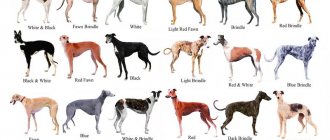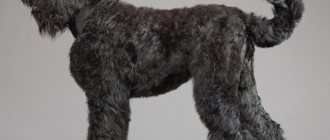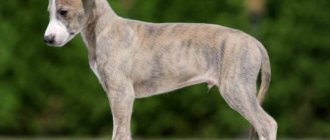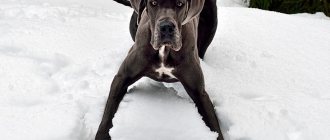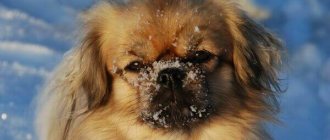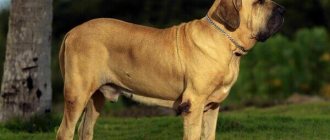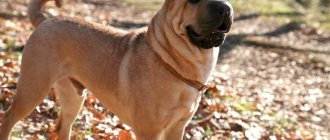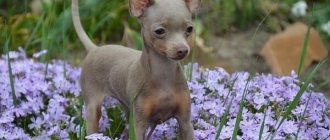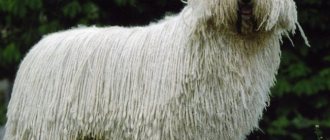a brief description of
- Other names: Puli, Hungarian Puli, Pulik (plural), Rasta Dog, Hungarian Water Dog, Hungarian Puli, Pulik, Water Shepherd, Hungarian Water Dog.
- Height: up to 47 cm at the withers.
- Weight: up to 15 kg.
- Color: exclusively black with a 5.1 cm white spot on the chest qualifies, white, gray and cream colors are acceptable, but only as a general morphology of the breed.
- Coat: long, growing throughout life, the outer layer is curly, lacking shine, the undercoat is soft, tightly woven, forms dreadlocks with interwoven awns, appearance – well-groomed.
- Life expectancy: up to 16 years.
- Advantages of the breed: Easily trainable, the Hungarian Puli is extremely intelligent and allows itself to be cunning in relation to its owner. Despite their independent character, animals are sensitive and very affectionate to humans.
- Difficulties: Dogs are quite talkative by nature, and it is difficult to train them to stop barking. Caring for bullets is complex, specific and requires professional grooming, especially when the wool cords have already been formed.
- Price: negotiable.
Breed characteristics
| Short description | |
| Origin: | Hungary |
| Conditions of detention: | In a house with a small or large garden |
| Purpose: | Herding dog, guard dog, companion dog |
| Color: | White |
| Wool length: | Long 27-30 cm |
| Adult dog size: | The height of females is 65 cm, males 70 cm, weight of males is approximately 50-60 kg, females - 40-60 kg |
| Average life expectancy: | 10-12 years |
| Walk: | If there is not enough space, at least 2 times a day, if the dog lives in the yard, once is enough |
| Physical activity needs: | Average physical activity needs (walking 1 to 3 hours per day) |
| Fédération Cynologique Internationale (FIC) classification: | Group 1: herding and cattle dogs, section 1: shepherd dogs |
| Puppy price: | 35000-70000 rubles |
Origin story
There is practically no data on the origin of the Hungarian Puli - this is how long ago representatives of the breed appeared next to humans. Over the course of hundreds of years, dogs have been subjected to selective breeding in an attempt to create the ideal shepherd's mate. But documentary support with entries in stud books began no more than one and a half hundred years ago.
The most valuable qualities of the breed were considered to be its ability to work. However, the Puli is one of those rare breeds whose exterior was assessed at the level of working qualities. At the beginning of the 18th century, nomads offered an astronomical sum for a bullet, a dog, the price of which could be equal to the annual earnings of a wealthy city dweller.
With the end of the era of poverty by 1800, an era of development began, affecting all spheres of human activity. Kinologiya was no exception. During this period, many dog breeds appeared that are still popular today. Strangely, the Puli belongs to those ancient generations of dogs that not only did not cease to exist, but also gave birth to new breeds, such as the Mudi, Briard, Pumi, and ultimately the Commander.
But the bullets, which were extremely popular in Hungary, never became widespread even in the territory of the Austro-Hungarian Empire, not to mention the world practice of raising dog breeds. The Hungarian Puli standard was approved in 1915, while the breed was presented at the World Dog Show only at the beginning of 1923. This period coincided with a wave of total immigration of Hungarians to the American continent, and many transported their favorites to America.
Personality of the Hungarian Shepherd
Puli has a friendly, calm character, so he is easy to train, he follows commands with pleasure, but does not tolerate excessive pressure.
A properly trained dog will never show aggression towards strangers, but will show that it is wary. The agile Hungarian Puli is unlikely to become a friend for older people, because you need to play a lot with your pet, run, and take long walks. An inactive lifestyle can affect the dog's character - he can become withdrawn.
White bullets
A dog is devoted to its owner if it feels reciprocal love. Usually she becomes attached to only one family member and considers him her master. She simply tolerates children, does not like excessive squeezing or pampering of the child, so it is not worth leaving the kids alone with the pet.
Puli reacts calmly to strangers in the house, but controls the situation. If the owner communicates normally with a stranger, then the dog will not interfere in the situation and protect the owner. Otherwise, the dog will begin to bark in warning and may rush without a command. It is better for outsiders to stay away from such a guard.
Puli was born to be the protector of sheep. Its character, intelligence, vigilance, mobility are the innate qualities of a shepherd dog. Although not all representatives of the breed are currently used on pastures, if necessary they will perform their function without prior preparation.
Attention! The Hungarian Puli Shepherd is selfish, loves attention, and will not tolerate its relatives, especially same-sex ones.
She will try to use force to drive the unwanted guest out of the territory. Interestingly, the dog is completely indifferent to cats, but will not tolerate the dominance of a meowing creature. Small rodents can easily be destroyed by bullets, considering them as objects for hunting.
Purpose of the breed
The total industrialization of 1900 and the introduction of industrial technologies into the agricultural sector deprived herding dogs of work in Hungary, and the breed slowly began to fade. The exact opposite was the fate of the bullets transported to America. The dogs adapted well to the local climate and became very popular among American farmers as intelligent and human-controlled dogs.
The bullet reached its peak of popularity when the US Government conducted tests of dogs of all breeds for guarding and herding livestock. The rapidly developing country was in dire need of four-legged helpers, and the bullets, according to test results, scored 85 points at the level of other breeds that barely reached the 30-point mark.
Representatives of the breed have also proven themselves excellent in the work of police stations, to which the bullets were involved literally immediately after the test tests. But first of all, the animal was regarded by the Americans as a faithful, devoted and intelligent companion dog.
Today, puli all over the world performs the task of a pet and a dog show participant. However, in their homeland, dogs began to be used again to guard flocks of sheep, but the popularity of the bullet never increased. The breed ranks 145th in the popularity rating out of 167 possible.
Character, learning ability and behavior
These shepherd dogs were developed for herding and guarding flocks of sheep, both day and night.
It is worth noting them as excellent companions for active and energetic families. She is very nimble with an inexhaustible supply of energy and an open and kind heart, ready to give all her love to your family. They are not lazy and need intense and vigorous exercise in order to stay in good shape not only physically, but also emotionally. They are best suited to living in the countryside, where they have plenty of space to run around, play, or fulfill their main purpose of herding livestock.
Walking and jogging are a mandatory program for them at least every day. Since he is a very smart pet, activities for him should be selected accordingly - interesting and complex, otherwise he will be bored and he will begin to find them himself, which can lead to damage to shoes and furniture.
Puli is first and foremost a shepherd and his goal in life is to herd and protect his flock. In this they are similar to the Finnish Spitz. If he doesn't have the opportunity to work with sheep, he will chase and circle around people. It is not recommended to leave him with small children, as during play he may accidentally push the baby or knock him down. It is worth noting their dislike for neighbor's children, especially if they are rude to your child.
He is very independent by nature, as the nature of the shepherd forces him to make his own decisions and therefore it is quite difficult to train them. You should start training from a very young age, before bad habits form. If the training is not organized correctly, he will consider himself a leader and will begin to ignore you.
Character
The breed of bullet is entirely positive. Temperamental and lively dogs have a cheerful and playful character. Pets are incredibly devoted to their owner and show their love for humans literally from birth.
It gets along well under the same roof with other representatives of the animal world - from rodents to predators, including reptiles. But small, passive animals can become the subject of playful hunting on the part of the dog, the outcome of which is not always predictable. Pools can be intolerant of neighboring dogs, especially those of the same sex, if they lack training and will aggressively drive the opponent out of their territory.
Bullets are not recommended as a pet for families where children have just started walking. A child's habit of grabbing and tasting everything can provoke resistance from the dog, since bullets tend to bite.
But the puliki do not even allow strangers to the threshold, announcing the appearance of uninvited guests with a powerful bark. Dogs are suspicious even of new family friends, gradually getting used to them.
Keeping a dog in an apartment or house
This breed is perfect for an apartment or a house, but it is not recommended to put them on a chain or in an enclosure, as they need constant contact with a person. But it should only be owned by active owners. She won't be able to wear a diaper; she needs to be walked and walked a lot. She needs long walks and physical activity for her health.
She won't be able to wear a diaper; she needs to be walked and walked a lot.
Puli is very attached to the owner and to the family where it lives, so shouting and punishment should be avoided. They also have a very hard time coping with a change of owner.
Choosing a puppy
It is possible that in order to get a pet of this breed, you will have to go to Hungary to get a Puli puppy, since the number of breed nurseries is extremely limited. Having previously agreed on the conditions for purchasing a puppy with the breeder, you need to personally make sure that you are purchasing a healthy Puli baby:
- active;
- curious;
- playful;
- moderately noisy, based on the specifics of the breed.
The documentation accompanying the purchase and sale transaction includes a veterinary passport, which contains the dates of vaccinations, a birth certificate, photocopies of the pedigree of the litter's parents, and recommendations for raising a little Puli from the breeder.
Selection and price of a puppy
In Russia and the CIS countries, special breed exhibitions are not held due to the small number of the breed, but several representatives can sometimes be found at large shows. There are good nurseries in many large cities, the main population is concentrated in Denmark, Finland and of course in Hungary. Puli babies from abroad will cost much more, but true lovers of the breed will have the opportunity to choose a good puppy of the desired color.
Puli puppies have short and soft hair, its active growth begins only after 3 months and is completed by 3 years. This makes the task of choosing a show dog much more difficult. Teenagers are more often purchased for exhibitions and breeding, but they are already much more expensive than kids. When choosing a dog, you should pay attention to the conditions of detention, the appearance of all puppies and parents; they should all be active, well-fed and healthy.
Prices for puppies are very different, it all depends on geography, pedigree, and demand. Puppies in kennels cost from 500 to 1,000 euros.
Advertisements for the sale of bullets without documents are very rare, which is an undoubted advantage for the breed, but a disadvantage for those who do not care about the breed, but are only interested in external similarity and low cost.
Nicknames and names
In the internal pedigree, which is subsequently exchanged for an international sample, the puppy’s name has already been entered by the breeder. As a rule, these are long pompous or historical names of great people, rarely used in everyday life.
Therefore, Puli owners give their dogs pet names - simple or meaningful. They reflect the character of the pet, are easy to pronounce, but do not have official recognition from the breed club. for male dogs are widespread : Arnie, Hudson, Borka. Lara, Millie, Lucy became popular names for females
Puli breed of dog. Hungarian Puli water dog. Puli.
Puli
DESCRIPTION . The cords of wool that cover the bullet's tightly knit body have become a trademark of this skilled shepherd. This is a compact, well-balanced dog with a square format. The head is somewhat domed, the skull is of medium width. The length of the muzzle is one third of the length of the head and ends with a large nose. A medium-sized dog with a moderately wide chest. The coat is thick and abundant on all parts of the body. Wavy or curly awns are never silky; the undercoat is soft. The fur itself gathers into cords, which are finally formed in an adult dog. Height at withers 35.5 - 48 cm. Weight 9 - 18 kg. The color of the bullet is usually dark - black, rusty black and gray, sometimes it can be apricot and white.
STORY . The statement that the Puli is a smaller form of the ancient Tibetan dog should rather be considered as speculation. Resembling the Tibetan Terrier in color and build, Puli may well be a small Komondor. The Chinese joke that Tibetans have given the world “the most beautiful women and the worst-tempered dogs.” Having migrated with the Magyars to the territory of modern Hungary, the Puli retained many of the features of its choleric Tibetan ancestor. The bullet learned to direct its ardor and perseverance towards fulfilling its shepherd duties. Her size and energy allow her to be a conscientious shepherd, and her innate belligerence allows her to be a fearless and reliable watchman. Dark corded wool protects the bullets from any weather and attack.
Excavations in Iraq have uncovered clay tiles dating back to around 3500 BC that mention this dog in the text. In the 9th century, puli was brought to Hungary, where it helped nomadic shepherds graze their cattle. The bullet has an innate ability for shepherd work: it only needs to watch the work of shepherds a few times in order to then act independently. She still has this ability to this day. Black color is inherited and is predominant, so gray dogs are rare.
CHARACTER. The Puli is not only a temperamental and intelligent dog, it is also alert and fearless and, if necessary, can fiercely protect its owners. In Hungary, larger dogs were used before even by the police.
CHARACTERISTIC. Puli participates in all types of dog sports and also acts as a reliable companion. This dog is best kept in a house with a large area that it can guard. Puli loves to bark, but at the same time has a sensitive character that requires sensitivity when raising her. Puppies are born with wavy hair; typical cords are formed only at a more mature age. When the wool begins to mat, it should be untangled by hand regularly.
FCI Standard: No. 55 / 13.09.2000 / GB
FCI Name: Puli (Black) Country of Origin: Hungary
Date of official publication of the previous standard: 04/06/2000
Original standard:
Puli (Black) (Hungarian Puli, Hungarian Water Dog)
Purpose: Shepherd dog.
FCI Classification Group 1. Guard and racing dogs (except Swiss Cattle Dogs). Section 1. Shepherd dogs.
No operational tests.
Brief history of the breed Hungarian herding dog breed of Asian origin. The bullets were brought to the territory of Hungary by eastern nomads, most likely the Magyars.
General appearance Puli (Black color) is a medium-sized dog, strong constitution, square, refined format, light in frame, but not excessively. The body is somewhat thin, well muscled. It is difficult to evaluate each part of the body of the Puli (Black) separately due to the thick coat, very curly and twisted into cords. Therefore, it is better to evaluate individual parts of the dog’s body by touch. Due to the excessively abundant hair on the head, the shape of the head appears round, the hair of the Puli (Black color) covers the eyes. A very bushy tail curled over the back gives the impression of a rising topline towards the croup.
Important proportions The length of the body is equal to the height at the withers. The depth of the Puli's (Black) chest is slightly less than half the height at the withers. The length of the muzzle is one third of the total length of the head.
Behavior The Hungarian Puli is a dog with a very lively temperament, extremely easy to train, loves children, and is an excellent watchdog. Used as a sport dog.
Head When viewed from the front, the head of the Hungarian Water Dog is round, but when viewed from the side it resembles an ellipse shape.
Skull part Skull The skull of Puli (Black) is small and thin. The brow ridges are highly developed.
The transition from forehead to muzzle is barely noticeable.
Facial region Nose very small, black.
Muzzle The muzzle of the Hungarian Puli is not pointed, with a straight back of the nose.
Lips The Puli (Black) has lips that fit tightly to the teeth, with dark pigmentation.
Teeth Complete scissor bite; in accordance with the dental formula. Puli (Black) has 42 teeth.
Eyes: Medium size, dark brown, moderately wide and slightly slanted. The expression in the eyes of the Hungarian Water Dog is lively and intelligent. The eyelids are dense and close to the eyeball, highly pigmented.
Ears : Moderately high set, wide at the base. The hanging part of the Bullet's (Black) ear resembles a "V" with rounded ends.
Neck The neck of the Puli (Black) is of medium length, elastic, very muscular, set at an angle of 45 degrees to the horizontal, covered with thick hair.
Body Topline The topline of Puli (Black) is straight. Due to the set and position of the tail, it gives the appearance of rising slightly upward towards the rear.
Withers Slightly projecting above the top line.
Back The back of Puli (Black) is of medium length, straight, dry and muscular.
Loin Puli (Black) has a very muscular, short loin.
Croup Short, slightly sloping.
Chest The Puli (Black) is characterized by a deep, long chest with curved ribs.
Underline Smoothly rising towards the rear.
Tail The tail of the Puli (Black) is set moderately high, curled into a tight-fitting ring over the croup, and abundantly covered with thick hair. When stretched, it reaches the hock joint.
Forelegs Shoulder blades Sloping, fitting tightly to the chest. A vertical line extending from the withers of the Puli (Black) touches the front point of the chest at its widest point. The angle of the scapulohumeral joint is from 100 to 110 degrees.
Shoulders Puli (Black) is characterized by medium-length, very muscular shoulders.
Elbows Bullet's elbows (Black) fit tightly to the chest. The angle between the shoulder and forearm is between 120 and 130 degrees.
Forearms Representatives of the Puli breed (Black color) are characterized by long, straight forearms with lean muscles.
Forelegs: Short, rounded, with tightly knit toes. Puli's (Black) claws are black or dark gray. The pads are dark and elastic. Puli's paws (Black) are parallel, moderately wide apart, looking forward.
Hindquarters Moderately widely spaced, parallel. The hip angle of the Puli (Black) is between 100 and 110 degrees. The angle of the knee joint is from 100 to 110 degrees.
Thighs and lower legs The thighs and lower legs of Puli (Black) are long and very muscular.
Hock joints Dry, clearly defined.
Metatarsus Short.
Hind legs The hind legs of the Puli (Black) are similar to the front legs, but flatter.
Movements Movements are lively and energetic. Puli (Black) has a short stride. The lynx is often characteristically mincing and jumping. Puli (Black color) tends to move in circles.
Skin Puli (Black color) is characterized by foldless, highly pigmented skin. Areas with slightly exposed, so-called bare skin, are black or dark gray for all color types.
The coat of Puli (Black) puppies is thick, wavy or curly. With age, the hair becomes woven into tassels and cords. The coat of the Puli (Black color) consists of guard hair and undercoat. The guard hair is coarser, the undercoat is finer. The ratio of these two layers determines the nature of the coat of the Puli (Black color). If the guard hair is clearly dominant compared to the undercoat, the coat structure is atypical. If the undercoat is clearly dominant - which is not desirable - the coat becomes overly matte and too soft in texture, making the Puli (Black) coat much more difficult to care for. If both layers of the coat are in the correct, genetically predetermined ratio, the appearance of the braids and cords that form the hairline is very aesthetic. And in this case, caring for the coat of Puli (Black color) is very easy. The longest cords (20-30 cm) cover the lower back, croup and inner thighs. The head coat is considered ideal for Puli (Black color) if the hair forms a strong structure consisting of cords that covers the facial area. Combed, unkempt, disheveled fur is undesirable.
Color Black.
Height and weight Height Puli males (Black): 39-45 cm, ideal height: 41-43 cm Puli females (Black): 36-42 cm, ideal height: 38-40 cm.
Weight Males: 13-15 kg. In females: 10-13 kg.
Disadvantages Any deviation from the above points is considered a defect, the degree of which is determined by how much it differs from the standard.
Grounds for disqualification Puli (Black color) lacks one or more teeth (incisors, canines, premolars 2-4, molars 1-2). Absence of more than two PM1. M3 are not taken into account. Undershot or overshot, jaw misalignment. Puli (Black color) wears a sickle-shaped or horizontal tail. Short, smooth, separately growing coat. Color defects. The Puli (Black color) has unwanted marks and spots. Deviations from the minimum or maximum height specified in the standard.
Males of the Puli breed (Black color) must have two normally developed testes, completely descended into the scrotum.
kinolog.biz
Care and maintenance
Unpretentious in maintenance, Puli feel great even in apartment housing, if the dog is given enough attention and provided with long walks, where the Puli can release all its accumulated energy. The Hungarian Water Shepherd generally does well in a family that leads an active lifestyle, and the owner often goes hiking and takes the pet with him on fishing, the beach, in the forest or on road trips.
The fur of an adult dog should not be combed. The puppy is scratched until the baby fluff fades. Around the age of 9 months, they begin to care for dreadlocks - woolen cords, breaking them into strands from the root to the ends of the hair with their fingers. The predominance of guard hair over the undercoat is considered a violation of the breed standard.
dogs with cosmetics. Despite its second name - the Hungarian Water Shepherd - the Puli does not recognize the water element at all and bathes only when necessary. But dogs' ears and eyes are regularly cleaned, but neither their claws nor their strong dental system require special care.
All that remains is to regularly worm the dog, fearing the development of helminthiasis, and at the slightest doubt about the health, immediately measure the pet’s temperature.
Content Features
Puli adapts perfectly to various living conditions. Dogs that are adopted as companions are content with the size of any apartment. Workers can live in barns with their charges and can tolerate both heat and cold well.
Energetic bullets will be involved in all household activities. In an apartment, dogs behave more reservedly than on the street, but even in a confined space you can appreciate their agility, maneuverability and jumping ability. The undoubted advantages of the breed are the absence of odor and shedding.
Training and physical activity
Puli needs good physical exercise, the dog needs regular long walks, the opportunity to frolic with his brothers and run around without a leash. Daily walks must be supplemented with games and training.
They are very easy to train and quickly remember commands.
In the process of education, preference should be given to the “carrot”. Praising you for doing the right thing will do more good than scolding you for doing the wrong thing. In addition, bullets are very sensitive. If desired, owners can participate with them in various sports: freestyle, agility, dancing with dogs. It is worth considering that the bullet needs constant mental stress. Over time, commands are forgotten.
Care
Caring for dogs with such an unusual coat is surprisingly easy.
At 8-12 months. Puppy fluff reaches the required length and begins to roll around the guard coat, crumbling into curls. The cords form independently, but periodically the wool needs to be inspected to ensure that the curls do not get tangled with each other. If this happens, they are carefully separated. You will have to especially carefully monitor the condition of the coat in the period from 8 months. up to 1.5 years. There is no need to comb or cut dogs. They are bathed once every 1-2 months. Eyes and ears are examined once a week and cleaned as they become dirty. Nails are trimmed every 3-4 weeks.
Feeding
The Puli's diet should be based on standard rules for feeding dogs. This can be natural food or ready-made food. Nutrition with natural products should be quite varied and balanced. The basis is meat and cereals; the diet includes fruits and vegetables; fermented milk and eggs are included several times a week. A natural diet is usually supplemented with food additives, vitamins and microelements. As for the choice of food, here first of all you should pay attention to the premium, super-premium or holistic class line. Diets designed for medium-sized dog breeds are suitable for puli. It is not worth giving special dietary foods unless necessary.
Health and heredity
Thanks to the purebred lines due to natural selection and non-interference by humans in the formation of the Hungarian Puli breed, the dog has excellent health and a strong immune system.
The only measure of preventive veterinary care for Pulikas is considered to be timely treatment of dogs for fleas and ticks, since blood-sucking parasites multiply well between dense strands of fur, causing significant harm to dogs.
Health
On average, a Hungarian Shepherd can live 12-13 years. Her health is good, her body’s immune defense is strong. These dogs are hardy and mentally stable. This characteristic of the breed, with regard to health, has remained unchanged for several centuries.
It is worth noting the bullet’s predisposition to the following diseases:
- Hypothyroidism – occurs due to insufficient amounts of hormones in the thyroid gland.
- Onychodystrophy is a pathology of the claws.
- Portosystemic shunt is an anastomosis between the veins of the gastrointestinal tract and the caudal vena cava.
- Erythematous pemphigus - usually occurs on the front of the head (the bridge of the nose and around the eyes), as well as on the ears.
- Tail shortening.
- Missing teeth.
- Dysplasia – brings severe pain, the dog limps and moves little.
- Diseases of the cardiovascular system.
- Dermatitis is a skin disease that requires long-term treatment.
- Diabetes.
Catering
The Puli breed is distinguished by its modest diet. Dogs are absolutely unpretentious in food and are able to accept absolutely any food, both ready-made food and natural food. However, breeders recommend feeding your dog specially formulated dry food from the Pro Plan brand for all age groups, including puppies. Premium dry food completely eliminates stomach upset and replenishes the energy spent by the dog during the day.
Bullet health
Hungarian Shepherds are considered a purebred breed. Puli are the result of nature's natural selection - that's why they have excellent health. Pets live on average 12-15 years.
Puppies must be vaccinated against the following diseases:
- plague;
- infectious hepatitis;
- parvovirus enteritis;
- leptospirosis;
- rabies;
- trichophytosis;
- coronavirus;
- parainfluenza
Attention! The vaccination schedule should be checked with your veterinarian. The doctor will also give instructions on how to care for your dog after vaccinations.
Despite good health, the bullet may have some diseases of the liver and pancreas, skin, eyes, and skeleton. There are heart diseases, dermatitis, allergies. Pathologies are not always congenital; perhaps the symptoms of the disease are the result of an incorrect lifestyle. In any case, you should consult a qualified veterinarian.
Education and training
Raising a dog begins from puppyhood. Due to its intelligence, the training process is quite simple. Once showing the dog the place of the toilet, the puppy will go to the diaper.
Puli are most often trained independently - the dog can be so obedient and attentively listen to the owner’s commands. The owners do not even resort to the services of a hired handler to participate in the dog show, methodically practicing movements in a simulated ring at home.
Naturally executive, Puli dogs strive to master new skills every day, trying to please their owner. As a rule, two or three lessons are enough for the dog to start asking to go outside to go to the toilet.
Training
Puli dogs become very attached to their owner. They unquestioningly obey instructions and diligently carry out commands. It is quite natural that a dog sometimes succeeds only on the second or even third try. You cannot raise your voice at an animal or punish it. In any training, it is important to be patient and be able to control yourself. Dogs are individual, some are agile, others jump better and run faster.
Bullet training begins from an early age, when the puppy first crosses the threshold of the house, which does not mean the requirement to drag a small pet to the field and force it to follow commands. Teach your little dog behavior skills daily.
For example, it’s not difficult to train and introduce the dog to sit when you start putting food in your pet’s bowl. In such cases, the dog constantly spins around the legs, expressing joy. Repeat the command for the puppy several times and sit it down, making it clear what you want to receive by saying the word “Sit.” Repeat the command constantly and you will soon see that your pet is able to sit quietly and wait for you to put food in the bowl.
Each dog learns certain norms of behavior and the ability to behave on the street. An ill-mannered individual can cause a lot of trouble if the owner did not find the time or did not show the proper patience in training. An untrained animal will have to be walked exclusively on a leash.
Naughty dogs are capable of bringing a lot of scraps from the trash into the house, not understanding that this should not be done. And the ban will simply go unnoticed. Moreover, if you try to take away what you found from the dog, you risk seeing the animal snarling.
If you are not sure that you can give your dog enough attention in training, feeding and care, do not rush to make a new friend. Even the Puli breed, which is universal and easily takes root in any place, must be provided with care and attention.
Advantages and disadvantages
Dogs capable of infecting all living things in the area with their cheerfulness. Playful and joyful, dogs remain characteristic animals, impatient of prolonged idleness and little activity of the owner. To work as a guard, a dog intended for herding sheep should be trained.
Bullets may experience fear, and then their behavior may become unsure of their actions. The dog is generally not aggressive towards animals, much less towards people, but is inclined to bite if it does not like something in the behavior of its opponent.
The main disadvantage, if it can be defined that way, is considered by some to be specific care for the coat, which often requires the intervention of a professional groomer.
Care
Complex and even unique. Puli's fur begins to turn into cords when she is nine months old. However, if you do not take care of them, they turn into tangles and cause pain to the dog.
Maintenance is quite simple, but takes a lot of time, especially for long cords.
Since the breed remains rare, owners resort to the services of professionals. Some people prefer to have their dogs trimmed.
They are also difficult to wash; even just to wet the cords takes up to half an hour. But it is much more difficult to dry it well, since wet wool can become a haven for fungus.
Reviews
Irina:
Puli is considered the Magyar shepherd queen. My princess is very cheerful and cheerful. When he grows up to the queen's age, he becomes even smarter. But in general, I have never met a more devoted and affectionate creature in my life.
Nikita:
Seeing bullets for the first time, an association arises with a rope mop in the sailor’s hand. But when you get to know each other better, you realize how smart the dog is. In addition, there is zero aggression, only some distrust at the very beginning of communication.
We invite everyone who is at least a little familiar with this rare breed of dog to communicate. We will be glad to receive additional information about the Hungarian Puli, its character, temperament and educational characteristics. We are waiting for your comments, which can be left at the bottom of the article.
Share
Leave a review
How to choose a puppy
The rarity of Komondors means that puppies are almost impossible to purchase from a private individual. That is, you will have to contact official nurseries. The dog can be adopted as early as 45 days, but it is worth considering that it will not be vaccinated.
The breeder must provide documents for the animal: passport and pedigree. In addition, he is obliged to tell everything about the puppies’ parents, their diseases and shortcomings, and show at least one of them.
Little Shepherds are active, curious and playful. External criteria must meet the standards: the coat is light and soft, the bite is correct, the nose is painted, the tail is short. The cost of a dog depends on its appearance.
- The most expensive will be the descendants of champions who are assigned show class ( from 70,000 rubles ).
- Pet class and breed class can be purchased for 35-50 thousand rubles .
The Hungarian Shepherd is certainly a wonderful guard, it is serious and brave, and can protect against any enemy. But this breed is suitable only for an experienced breeder who has enough time and financial resources to maintain it. It’s impossible to make an apartment toy out of this dog.
Feeding
Excellent health allows you to choose any available feeding method. It is better to choose high-quality food, as for other dogs, simply because they contain enough useful substances. Otherwise, the dog will need expensive vitamin complexes to maintain the immune system, bone strength, and so on.
Homemade food should include a large amount of carbohydrates. It is necessary to feed the dog porridge, meat or meat scraps, bones, and cartilage. It is also important to provide vegetables and fruits. Vitamin supplements should not be neglected; they should be mixed into the food daily.
No matter what food is chosen for your dog, he should always have access to clean, cool water.
Description of the breed
The body of the bullet has a square shape, less often – slightly elongated. In profile the head is oval, in front it is round. The eyes are dark brown, almond-shaped, rather large, but always covered with fur. The nose is black and large. All teeth must be present. The ears are drooping, close to the head, and difficult to see due to the large amount of fur. The tail is quite short, but is always tucked towards the back.
The coat is long, thick, wavy. From an early age, it begins to fall off, forming cords of different lengths, depending on its location. They are shorter on the head and longer on the torso. The undercoat is dense and soft. The color can be light or dark. White, cream, silver, brown, brindle are allowed, but the most popular and widespread is black.
Animal health
The purebred nature of the breed and the complete work of nature through natural selection have endowed the Puli with excellent health and immunity.
The main thing you need to focus on is timely treatment for skin parasites. Since woolen dreadlocks are an excellent breeding ground for blood-sucking reptiles.
Bullets do not suffer from hereditary diseases. This is the main and tangible plus in their health.
Vaccination of dogs is carried out after deworming in 7-10 days. It is best to seek help from a veterinary clinic, where the dog will be issued a special passport, which will contain all the information about the vaccinations and procedures performed.
Puppy cost
A puppy cannot be cheap, especially in Russia, since it is a rather rare breed.
Prices range from 45,000 rubles to 80,000.
The final price tag directly depends on the title and working qualities of the parents. It is best to purchase a puppy through a professional nursery or a trusted breeder. Otherwise, you may end up buying a mongrel puppy.
You need to train a dog from childhood, but training is easy
The most famous breeding nurseries in Russia:
- Rublevka Rasta, Moscow region, village. Petrovo-Dalnee.
- Matthias Rex, Kaluga region, Zhukov.
- Legend of Transbaikalia, Chita.
- Unreal Crutble, Irkutsk.

